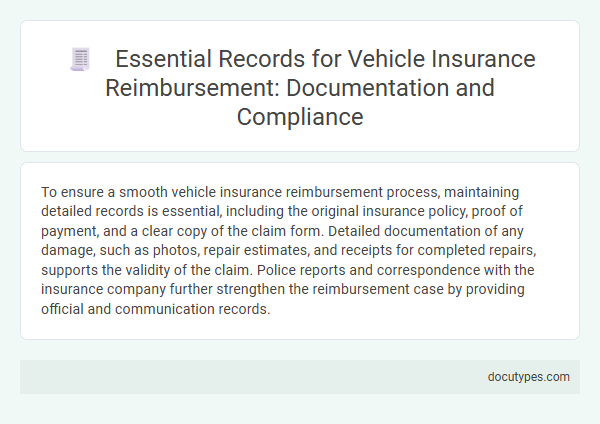To ensure a smooth vehicle insurance reimbursement process, maintaining detailed records is essential, including the original insurance policy, proof of payment, and a clear copy of the claim form. Detailed documentation of any damage, such as photos, repair estimates, and receipts for completed repairs, supports the validity of the claim. Police reports and correspondence with the insurance company further strengthen the reimbursement case by providing official and communication records.
Introduction to Vehicle Insurance Reimbursement
| Introduction to Vehicle Insurance Reimbursement | |
|---|---|
| Vehicle Insurance Reimbursement | Compensation provided by an insurance company to the policyholder for covered vehicle-related expenses following an accident, theft, or damage. |
| Purpose | To financially recover costs such as repairs, medical expenses, or total loss of the insured vehicle. |
| Required Records Overview | Documentation essential for validating claims and processing reimbursement accurately and promptly. |
| Key Records Required for Vehicle Insurance Reimbursement | |
| Insurance Policy Document | Proof of active coverage and policy details including limits, deductibles, and exclusions. |
| Accident Report | Official police or incident report detailing the circumstances and parties involved in the claim event. |
| Repair Estimates and Invoices | Itemized cost breakdowns from licensed repair shops or automotive service providers. |
| Proof of Ownership | Vehicle registration or title documents confirming the policyholder's legal ownership of the insured vehicle. |
| Medical Records | Documentation of injuries and medical treatment if bodily harm occurred in the incident. |
| Photographic Evidence | Images of vehicle damage, accident scene, and any relevant conditions supporting the claim. |
| Communication Records | Correspondence with the insurance company including claim forms, emails, and letters. |
Importance of Proper Documentation
What records are required for vehicle insurance reimbursement? Proper documentation is crucial to ensure a smooth and timely claims process. Essential records include the insurance policy, police reports, repair invoices, and photographs of the damage.
Required Personal Identification Records
To process vehicle insurance reimbursement, required personal identification records must be submitted. These typically include a valid government-issued photo ID such as a driver's license or passport.
Your proof of identity establishes ownership and eligibility for the claim. Accurate personal identification ensures smooth verification and timely reimbursement from the insurer.
Proof of Vehicle Ownership Documents
Proof of vehicle ownership documents are essential for vehicle insurance reimbursement claims. These documents confirm your legal right to the vehicle and validate the legitimacy of the claim.
- Vehicle Title - The official document that proves your ownership of the vehicle.
- Registration Certificate - A government-issued certificate that links the vehicle to your name.
- Bill of Sale - A receipt or contract showing the purchase details and transfer of ownership.
Insurance Policy Details and Certificates
Maintaining accurate insurance policy details and certificates is essential for vehicle insurance reimbursement claims. These documents verify coverage and support the validation of your claim with the insurer.
- Insurance Policy Number - The unique identifier for your vehicle insurance contract is necessary to track and process your reimbursement claim efficiently.
- Certificate of Insurance - This official document shows proof of active insurance coverage at the time of the incident, confirming eligibility for reimbursement.
- Endorsement and Renewal Records - Any modifications or renewal certificates related to the insurance policy provide evidence of continued or updated coverage terms.
Accident and Incident Reports
Accident and incident reports are essential records required for vehicle insurance reimbursement claims. These reports provide detailed accounts of the event, including the date, time, location, and parties involved.
Insurance companies use these documents to verify the circumstances and assess the validity of the claim. Accurate and comprehensive reports help expedite the reimbursement process and ensure proper compensation for damages.
Repair Estimates and Invoices
Repair estimates and invoices are essential records for vehicle insurance reimbursement as they document the cost of damages and repair work. Insurance companies use these documents to verify the extent of damage and determine the appropriate payout. Keep your repair estimates and final invoices organized to ensure a smooth reimbursement process.
Photographic Evidence and Supporting Media
Photographic evidence is essential for vehicle insurance reimbursement as it provides clear documentation of the damage incurred. High-quality images captured immediately after the incident help validate the claim and prevent disputes.
Supporting media, such as videos or dashcam footage, further strengthens the case by offering a dynamic view of the accident or event. These records should clearly depict the extent of vehicle damage, license plates, and the surrounding environment. Properly timestamped and geotagged media increase the accuracy and reliability of the insurance claim process.
Timeline Compliance for Submitting Claims
Submitting your vehicle insurance reimbursement claim requires maintaining accurate records such as the accident report, repair invoices, and proof of payment. Ensuring these documents are submitted within the insurer's specified timeline, often ranging from 30 to 60 days after the incident, is critical for claim approval. Timely compliance with these deadlines helps avoid delays or denials in receiving your reimbursement.
What Records Are Required for Vehicle Insurance Reimbursement? Infographic

